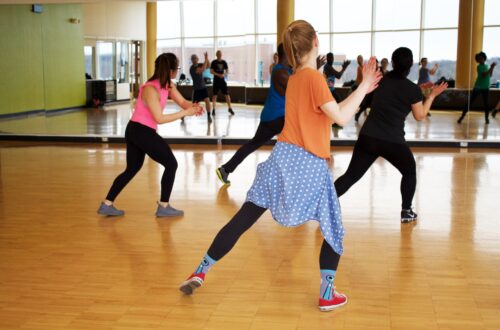
Knockout Facts: All You Need to Know About Kickboxing
If you’re looking for a challenging and exciting workout, look no further than kickboxing. Kickboxing is a martial art that has been developed by combining different techniques from karate, boxing, and Muay Thai.
This high-intensity combat activity has been gaining popularity worldwide and for good reason. Not only does it provide an adrenaline-pumping experience, but it also offers numerous health and fitness benefits.
Originating in Japan in the 1960s, kickboxing gained popularity in the United States during the 1970s and is now a well-known sport practiced worldwide.
Combining elements of various martial arts and combat sports, kickboxing is a full-body workout that can improve your fitness and build your strength and endurance.
In this blog post, we will cover the basics of kickboxing, including its history, techniques, and benefits.
Techniques in Kickboxing
Kickboxing incorporates four basic techniques: punches, kicks, knee strikes, and Elbow strikes. These techniques require a great deal of coordination, balance, and strength.
1. Punches:
Punches are hand strikes used in kickboxing to hit the opponent from various angles and distances. Common punches include:
Jab: A quick, straight punch thrown with the lead hand. The jab is used to set up combinations, gauge distance, and keep the opponent on the defensive.
Cross: A powerful straight punch delivered with the rear hand. It generates significant force and can be used to follow up after a jab or as a standalone attack.
Hook: A lateral punch thrown in a circular motion with the lead hand. The hook targets the side of the opponent’s head or body, and it is effective in close-range combat.
Uppercut: An upward punch aimed at the opponent’s chin, thrown from a bent elbow position. The uppercut is effective in close quarters and can be devastating when delivered with proper technique.
2. Kicks:
Kicks are powerful leg strikes that allow kickboxers to attack from a distance and target various areas of the opponent’s body. Basic kicks in kickboxing include:
Front Kick (Front Push Kick or Teep): A push kick executed with the ball of the foot, targeting the opponent’s midsection. The front kick is versatile, serving as both an offensive and defensive move to create distance.
Roundhouse Kick: A powerful kick delivered in a circular motion, striking with the top of the foot or shin. The roundhouse kick targets the head, ribs, or legs, and it’s one of the most iconic techniques in kickboxing.
Side Kick: A thrusting kick delivered from the side, utilizing the heel or blade of the foot. The sidekick is ideal for pushing opponents away or targeting the midsection.
3. Knee strikes:
Knee strikes are performed in the clinch, a close grappling position, where fighters are in tight contact. Knee strikes involve raising the knee to hit the opponent’s body or head, and they can be devastating when executed with proper technique and leverage.
4. Elbow strikes:
Elbow strikes are close-range strikes using the elbow, typically targeting the opponent’s head, collarbone, or other vulnerable areas. Elbow strikes are potent and can cause significant damage, making them a valuable tool in kickboxing.
Rules and Regulations in Kickboxing
Kickboxing, like any other combat sport, has specific rules and regulations in place to ensure fair competition, maintain the safety of the fighters, and govern the conduct of the matches.
While the rules can vary slightly based on the kickboxing organization or event, some common rules and regulations include:
1. Weight Classes: Kickboxing competitions usually have weight classes to ensure fair matchups between fighters of similar size and weight. This helps prevent significant advantages in strength and reach.
2. Ring Dimensions: The ring used in kickboxing matches has specific dimensions, usually between 16 to 24 feet in diameter. The ropes surrounding the ring should be appropriately padded for safety.
3. Attire and Protective Gear: Fighters must wear approved protective gear, including mouthguards, gloves, shin guards, and groin protectors. The use of hand wraps is also common to provide additional wrist support.
4. Prohibited Techniques: Certain techniques may be banned in kickboxing, such as strikes to the back of the head, throat, or groin. Biting, headbutting, and striking with the knees or elbows may also be disallowed, depending on the specific rules.
5. Scoring System: Kickboxing matches are typically scored based on effective striking techniques and defense. Judges assign points for clean and powerful hits while considering the overall control and aggressiveness displayed by each fighter.
6. Clinching and Grappling: The rules regarding clinching and grappling may vary depending on the style of kickboxing. Some competitions allow limited clinching time, while others encourage continuous action.
7. Knockdowns and Knockouts: A fighter is considered knocked down when any part of their body, other than their feet, touches the ground. Knockdowns can result in a standing count by the referee. A knockout occurs when a fighter is unable to continue after being knocked down.
8. Rounds and Breaks: Kickboxing matches are typically divided into several rounds, each lasting two to three minutes, with one-minute breaks between rounds to allow fighters to recover.
9. Referee and Judges: A referee oversees the match to ensure adherence to the rules and the safety of the fighters. Judges score the bout from ringside based on their observation of the action.
10. Fouls and Disqualifications: Fighters are expected to show good sportsmanship and follow the rules. Committing fouls, such as hitting below the belt, biting, or headbutting, can lead to warnings, point deductions, or even disqualification, depending on the severity.
Benefits of Kickboxing
It offers a wide range of physical, mental, and emotional benefits that make it a popular and rewarding activity for people of all ages and fitness levels.
Here are some of the key benefits of kickboxing:
1. Cardiovascular Fitness: Kickboxing is a high-intensity aerobic workout that gets your heart pumping and improves cardiovascular endurance. Regular kickboxing sessions can enhance your lung capacity, reduce the risk of heart disease, and boost your overall cardiovascular health.
2. Full-Body Workout: This exercise engages multiple muscle groups in the upper and lower body, providing a comprehensive full-body workout. It helps build strength, tone muscles, and improve flexibility and coordination.
3. Weight Loss and Fat Burning: With its combination of dynamic movements and high-energy exercises, kickboxing is an effective way to burn calories and aid in weight loss. It can help increase metabolism and contribute to a more toned physique.
4. Stress Relief: Kickboxing serves as an excellent stress reliever. Physical activity and the release of endorphins during exercise can reduce stress, and anxiety, and improve mood. It provides a healthy outlet to release pent-up energy and frustration.
5. Self-Defense Skills: Kickboxing teaches practical self-defense techniques, empowering participants with the knowledge and ability to protect themselves in real-life situations. Knowing how to throw punches, kicks, and knee strikes can boost self-confidence and personal safety.
6. Improved Balance and Coordination: The precise movements and footwork involved in kickboxing improve balance and coordination. This enhanced body awareness can have positive effects on daily activities and sports.
7. Increased Flexibility: The various kicks and stretches in kickboxing contribute to improved flexibility, reducing the risk of injuries and promoting a better range of motion.
8. Core Strengthening: The core muscles are continuously engaged during kickboxing to maintain stability and generate power. A strong core improves posture and reduces the risk of back pain.
9. Boosted Energy Levels: Regular kickboxing workouts can lead to increased energy levels and reduced feelings of fatigue. As your fitness improves, you’ll experience more vitality throughout the day.
10. Social Interaction: Joining a kickboxing class can provide a sense of community and social interaction. It allows you to meet like-minded individuals, create workout buddies, and make new friends.
11. Mental Focus and Discipline: Kickboxing requires mental focus and concentration, helping improve discipline and mindfulness. The combination of physical and mental demands in kickboxing can enhance cognitive abilities.
12. Fun and Enjoyment: Kickboxing offers an enjoyable and dynamic workout experience. The excitement of learning new techniques and combinations can make each session a fun and rewarding experience.
Kickboxing As a Sport
A popular combat sport called kickboxing combines aspects of boxing with different martial arts. It involves striking with punches, kicks, knee strikes, and elbow strikes.
As a competitive sport, kickboxing has gained significant global recognition and a dedicated following due to its thrilling and action-packed nature.
The numerous professional organizations that host prestigious competitions and events, such as GLORY, K-1, and WAKO, are evidence of kickboxing’s appeal on a global scale. Its physical demands enhance cardiovascular endurance, strength, flexibility, and coordination, promoting overall fitness.
Beyond the athletic aspects, kickboxing promotes mental discipline and strategic thinking by requiring fighters to stay focused and adapt during bouts. Furthermore, it provides individuals with practical self-defense skills, boosting their self-confidence.
The sport’s global popularity attracts enthusiasts from diverse backgrounds, creating a sense of community and camaraderie among practitioners.
Whether as a professional competitor or fitness enthusiast, kickboxing offers an electrifying and engaging journey, exemplifying the fusion of athleticism and martial arts.
Conclusion
kickboxing is an electrifying sport that offers a unique blend of physical and mental benefits. From honing self-defense skills to boosting overall fitness, kickboxing provides a holistic approach to health and well-being.
With proper technique and safety precautions, kickboxing can be enjoyed by people of all ages and fitness levels. It’s a great way to stay in shape, relieve stress, and learn self-defense skills.
If you’re looking for a new way to challenge yourself physically and mentally, kickboxing is definitely worth trying.
Lorem ipsum dolor sit amet, consectetur adipiscing elit. Ut elit tellus, luctus nec ullamcorper mattis, pulvinar dapibus leo.


You May Also Like

Aerobics: The Fun, Effective, and Affordable Way to Get in Shape
12 September 2024
Intermittent Fasting: The Diet Trend That Actually Works
19 September 2023
